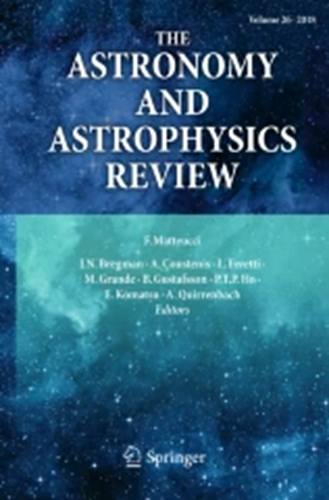对碰撞场中透镜x射线源的系统搜索
IF 26.5
1区 物理与天体物理
Q1 ASTRONOMY & ASTROPHYSICS
引用次数: 1
摘要
我们用钱德拉的数据在11个碰撞星系团的视场中寻找透镜源的未解析x射线发射。我们考虑透镜平面上的立体角对应于放大倍数$\mu>1.5$,总计约100角分$^2$。我们的主要目标是评估大质量星团作为宇宙望远镜探索银河系外x射线源群的微弱末端的效率。我们从光学中识别的强透镜源中搜索x射线发射,并对透镜x射线源进行非靶向检测。我们仅在849个透镜/背景光源中的9个中检测到x射线发射。没有检测的源的叠加发射在任何波段都不显示任何信号。基于非目标探测,我们发现了66个与透镜源一致的额外x射线源。在考虑完整性和天空覆盖后,我们首次测量了透镜x射线源的软带和硬带计数。结果与目前的AGN种群分布模型一致。在中深碰撞场中发现的源去透镜通量分布在软带和硬带分别达到~$10^{-16}$和~$10^{-15}$ erg/s/cm$^{2}$的通量极限。我们得出的结论是,为了匹配CDFS作为宇宙望远镜开发大质量星团的深度,所需的星团场数量比钱德拉20年档案提供的数量要大两个数量级。当未来的x射线设备具有~1'角分辨率和大有效面积时,将允许偶然发现罕见的,强透镜的高$z$ x射线源,从而能够研究早期宇宙中微弱的AGN活动和测量多重成像AGN x射线变异性的引力时间延迟,这将是一个重要的进步。本文章由计算机程序翻译,如有差异,请以英文原文为准。
Systematic search for lensed X-ray sources in the CLASH fields
We search for unresolved X-ray emission from lensed sources in the FOV of 11 CLASH clusters with Chandra data. We consider the solid angle in the lens plane corresponding to a magnification $\mu>1.5$, that amounts to a total of ~100 arcmin$^2$. Our main goal is to assess the efficiency of massive clusters as cosmic telescopes to explore the faint end of X-ray extragalactic source population. We search for X-ray emission from strongly lensed sources identified in the optical, and perform an untargeted detection of lensed X-ray sources. We detect X-ray emission only in 9 out of 849 lensed/background optical sources. The stacked emission of the sources without detection does not reveal any signal in any band. Based on the untargeted detection, we find 66 additional X-ray sources that are consistent with being lensed sources. After accounting for completeness and sky coverage, we measure for the first time the soft- and hard-band number counts of lensed X-ray sources. The results are consistent with current modelization of the AGN population distribution. The distribution of de-lensed fluxes of the sources identified in moderately deep CLASH fields reaches a flux limit of ~$10^{-16}$ and ~$10^{-15}$ erg/s/cm$^{2}$ in the soft and hard bands, respectively. We conclude that, in order to match the depth of the CDFS exploiting massive clusters as cosmic telescopes, the required number of cluster fields is about two orders of magnitude larger than that offered by the 20 years Chandra archive. A significant step forward will be made when future X-ray facilities, with ~1' angular resolution and large effective area, will allow the serendipitous discovery of rare, strongly lensed high-$z$ X-ray sources, enabling the study of faint AGN activity in early Universe and the measurement of gravitational time delays in the X-ray variability of multiply imaged AGN.
求助全文
通过发布文献求助,成功后即可免费获取论文全文。
去求助
来源期刊

The Astronomy and Astrophysics Review
地学天文-天文与天体物理
CiteScore
45.00
自引率
0.80%
发文量
7
期刊介绍:
The Astronomy and Astrophysics Review is a journal that covers all areas of astronomy and astrophysics. It includes subjects related to other fields such as laboratory or particle physics, cosmic ray physics, studies in the solar system, astrobiology, instrumentation, and computational and statistical methods with specific astronomical applications. The frequency of review articles depends on the level of activity in different areas. The journal focuses on publishing review articles that are scientifically rigorous and easily comprehensible. These articles serve as a valuable resource for scientists, students, researchers, and lecturers who want to explore new or unfamiliar fields. The journal is abstracted and indexed in various databases including the Astrophysics Data System (ADS), BFI List, CNKI, CNPIEC, Current Contents/Physical, Chemical and Earth Sciences, Dimensions, EBSCO Academic Search, EI Compendex, Japanese Science and Technology, and more.
 求助内容:
求助内容: 应助结果提醒方式:
应助结果提醒方式:


